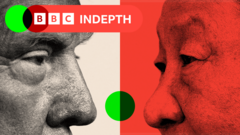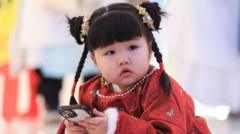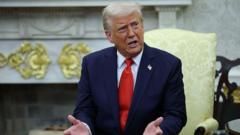The intricate relationship between Donald Trump and Xi Jinping has fluctuated dramatically, characterized by moments of camaraderie and periods of sharp conflict. With Trump’s expected return to the White House, experts ponder whether they can navigate the challenges and potentially find common ground once more.
Trump and Xi: Navigating the Highs and Lows of a Complex Relationship

Trump and Xi: Navigating the Highs and Lows of a Complex Relationship
As tensions rise, will Trump's return herald a new era in US-China relations?
In a Beijing park filled with elderly locals exercising, the sun peeks through cypress trees, casting a warm glow on the mingling voices of residents reflecting on their country’s progress. These pensioners remember when their factories drove China's economy to rival that of the United States, yet anxiety surrounds the implications of returning US policies under President Trump, especially considering his past threats of significant tariffs against Chinese imports.
Despite the tension, the sentiment on the ground is mixed. Many see Trump as a humorous figure—his infamous dance moves have become popular memes, eliciting both laughter and apprehension among Chinese citizens who regard him as capricious. The selection of hardline candidates for his cabinet, especially those openly critical of China, has only deepened worries about what a second Trump term might entail for bilateral relations.
Historically, Chinese and American leaders have struggled to maintain a steady partnership. Trump’s previous term saw a dramatic decline in collaboration, notably during the trade war initiated amid the COVID-19 outbreak, which Trump controversially dubbed the "Chinese virus." Nevertheless, there was a period in 2017 when a ceremonial atmosphere marked their relations, highlighted by Xi's unprecedented hospitality towards Trump.
As the landscape evolves, Trump steps back into a geopolitical arena that has grown more adversarial, with new warnings from Xi about a potential cold war. With Trump’s assertive stance anticipated to intensify as he solidifies his roster of advisors, a continued focus on military readiness and tariffs could be on the horizon.
Contrastingly, Xi looks to assert China's ambitions, fueled by warnings from analysts: a stronger military and economic posture, alongside troubling economic conditions at home, depict a nation not willing to back down. For the average citizen, economic instability fuels local fears for their futures—an apprehension mirrored in the calls for jobs and stability echoing from public parks.
Meanwhile, conversations about dependence on foreign partnerships highlight looming uncertainty. Xi's efforts to reshape China’s role on the world stage amid American withdrawal and the introduction of aggressive tariffs create a complex backdrop for the relationship.
Moreover, the role of figures like Elon Musk emerges as a wild card, representing the private sector's potential influence in tempering Trump’s more aggressive trade policies. With China serving as his production base for Tesla, Musk’s relationship with Trump may hold key implications for economic discourse.
As these dynamics unfold, experts draw attention to the critical question: can Trump and Xi reshape their narratives to foster stability, or will they plunge into a renewed whirlwind of conflict? For now, the sentiment in the parks of Beijing seems to lean towards caution as citizens watch and wait, aware that the future isn't set in stone, but is ripe with possibilities for both nations.
Despite the tension, the sentiment on the ground is mixed. Many see Trump as a humorous figure—his infamous dance moves have become popular memes, eliciting both laughter and apprehension among Chinese citizens who regard him as capricious. The selection of hardline candidates for his cabinet, especially those openly critical of China, has only deepened worries about what a second Trump term might entail for bilateral relations.
Historically, Chinese and American leaders have struggled to maintain a steady partnership. Trump’s previous term saw a dramatic decline in collaboration, notably during the trade war initiated amid the COVID-19 outbreak, which Trump controversially dubbed the "Chinese virus." Nevertheless, there was a period in 2017 when a ceremonial atmosphere marked their relations, highlighted by Xi's unprecedented hospitality towards Trump.
As the landscape evolves, Trump steps back into a geopolitical arena that has grown more adversarial, with new warnings from Xi about a potential cold war. With Trump’s assertive stance anticipated to intensify as he solidifies his roster of advisors, a continued focus on military readiness and tariffs could be on the horizon.
Contrastingly, Xi looks to assert China's ambitions, fueled by warnings from analysts: a stronger military and economic posture, alongside troubling economic conditions at home, depict a nation not willing to back down. For the average citizen, economic instability fuels local fears for their futures—an apprehension mirrored in the calls for jobs and stability echoing from public parks.
Meanwhile, conversations about dependence on foreign partnerships highlight looming uncertainty. Xi's efforts to reshape China’s role on the world stage amid American withdrawal and the introduction of aggressive tariffs create a complex backdrop for the relationship.
Moreover, the role of figures like Elon Musk emerges as a wild card, representing the private sector's potential influence in tempering Trump’s more aggressive trade policies. With China serving as his production base for Tesla, Musk’s relationship with Trump may hold key implications for economic discourse.
As these dynamics unfold, experts draw attention to the critical question: can Trump and Xi reshape their narratives to foster stability, or will they plunge into a renewed whirlwind of conflict? For now, the sentiment in the parks of Beijing seems to lean towards caution as citizens watch and wait, aware that the future isn't set in stone, but is ripe with possibilities for both nations.




















